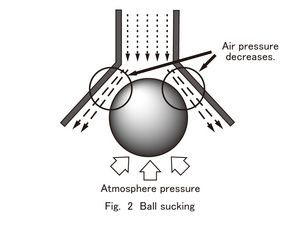Nagoya City Science Museum
TOP > Exhibition Guide > Keyword Search > Starting with "V" > vortex > Floating Balls / Ball Sucking
Floating Balls / Ball Sucking



Purpose of Exhibition
Push the button to blow the air flow,and the balls float. Even wobbling, floating balls stay in the air and do not drop. The secret is in the shape of the balls and the flow of air.
In this exhibit, we can learn about the characteristics of the invisible air flow from the movement of the balls.
Additional Knowledge
[Floating Balls]
Balls float because of the air flowing from bellow. Because the air hits a round shape (the ball), it flows smoothly along the surface of it, like 'wrapping around' the ball. The balls float receiving the air from below, but the reason why they don't drop in spite of moving in all directions is that the flowing air is wrapping around them. This air vortex of the surface of the ball makes layers like an onion.
This flow is called the "laminar flow" (Figure 1).
If the air flow hitting the balls is too strong, it bounces and makes a small vortex; the "laminar flow" does not exist. The air does not wrap around the ball neatly, then, the balls cannot float stably in the air.
[Aspirated Balls] When a ball moves close to the umbrella, the ball is attracted to it and floats up.
As for aspirated balls, when the ball gets close to the umbrella and the space between the balls and the umbrella narrows, the pressure decreases.
For this, the upward force of the balls is working until the balls get close to the umbrella, that's why the balls are aspirated (Figure 2).
Article by Tetsuro Ojio and Yoshitaka Yamada, curator
